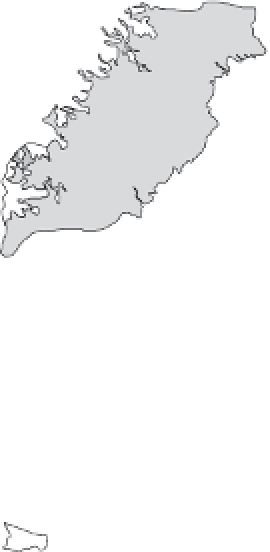Environmental Engineering Reference
In-Depth Information
Mor (0-8 cm)
Hg, mg/kg
B-Horizon (15-30 cm)
Hg, mg/kg
Parent material (ca 50 cm)
Hg, mg/kg
< 0.25
< 0.01
< 0.01
0.25-0.30
0.30-0.35
0.35-0.40
0.40-0.45
> 0.45
No data
0.01-0.02
0.02-0.03
0.03-0.04
0.04-0.05
> 0.05
No data
0.01-0.02
0.02-0.03
0.03-0.04
0.04-0.05
> 0.05
No data
FIGURE 8.2
Spatial distribution of soil THg concentrations at three different depths in Sweden.
2002). In boreal wetlands Moore et al. (1995) found
4-160 ng g
-1
THg and 0.1-139 ng g
-1
MeHg, with the low-
est values in shrubs and highest in mosses. For a given
land area, the mass of Hg in vegetation was similar to the
mass of Hg in porewater but was only a small fraction of
the mass of Hg in peat. In general, THg and MeHg concen-
trations increased with increasing proximity of the plant's
habitat to the water table, though some upland mosses also
had high concentrations. Hall and St. Louis (2004) reported
THg concentrations near 10 ng g
-1
in needles/leaves,
5-30 ng g
-1
in shrubs, 33 ng g
-1
in lichen, and 50-100 ng g
-1
in mosses.
t he lack of measu rements i in soi ls relat ive to aquat ic systems.
Skyllberg et al. (2003), working in a gradient from upland
mineral soils to riparian peats and wetlands reported soil
THg in Sweden ranging from 10 to 115 ng g
-1
and soil
MeHg ranging from
0.05 to 13.4 ng g
-1
, with concentra-
tions generally greatest toward the stream. Soil MeHg:THg
ratios in this study ranged from 0.004 to 0.17.
In stream
sediment,
THg concentration is commonly low because
organic matter is poorly retained, but in lakes and oceans,
sediments represent a large repository for Hg.
The recent era of anthropogenic emissions has increased
Hg deposition by a factor of 3 - 4. Moder n Hg concentrations
in organic horizons of northern temperate and boreal soils
(Figure 8.2) have increased by a similar factor (Johansson
et al., 1995, 2001). Demers et al. (2007) found that forest
litter accumulated THg over time. Hall and St. Louis (2004)
and Heyes et al. (1998) found that THg was lost from decom-
posing litter over time, but at a slower rate than total litter
mass loss. Indeed, Alriksson (2001) found higher Hg within
the lower mor layer (which is older and more degraded), as
compared with the upper mor layer at sites across Sweden,
supporting the idea that Hg is retained as organic mat-
ter breaks down. THg concentrations are generally much
higher in the forest fl oor relative to mineral soil (Grigal,
2003). However, given the greater thickness and higher
bulk density of the mineral soil, the pool of Hg in the min-
eral soil can be several times to well over an order of magni-
tude greater than that in the forest fl oor. Analogously, peats
commonly have lower THg concentrations than adjacent
upland soils (Schwesig et al., 1999), but may hold a greater
pool of Hg where deposits are deep. Grigal (2003) calculated
that peatlands store 1000 times more Hg per unit area than
annual atmospheric deposition of Hg.
Soils
Chapter 7 has a complete treatment of soil Hg, but we pres-
ent here some contextual information to help in under-
standing terrestrial Hg cycling. Hg content in soils is
typically on the order of 100 ng g
-1
. As reported in Grigal
(2003), Rundgren et al. (1992) compiled Hg concentrations
in European soils and found nearly identical Hg of about
140 ng g
-1
in natural (mostly forest, n
50) and agricultural
48) soils. Industrially contaminated soils can have
much higher Hg concentrations, up to 1500 ng g
-1
(Zhao
et al., 20 08). Nater and Grigal (1992) reported THg in humus
of 100-250 ng g
-1
and THg in mineral soil of 15-30 ng g
-1
in
forest soils of the upper midwestern United States. Wiener
et al. (2006) reported THg averages of 324 ng g
-1
in the
O horizon, 126 ng g
-1
in the A horizon, and 49 ng g
-1
in
the C horizon, as compared with
(n
20 ng g
-1
in bedrock
(assumed to be geogenic Hg). Wiener et al. (2003) summa-
rized the range of MeHg concentrations as 0.2-0.5 ng g
-1
in
organic soils and
0.05 ng g
-1
in mineral soils, but stressed























































